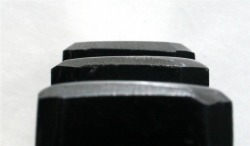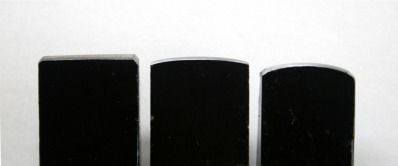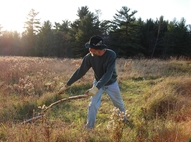 I've been meaning to write this all summer. Pictured here at left is a Picard combination scythe hammer, and a very nice little Peddinghaus combination scythe hammer. In my peening manual, I rave about what a great peening hammer the Picard Company makes. Excellent steel and hardness, and I like the camber of the hammer face and cross-peen better than the Peddinghaus. I received my first shipment of Picard hammers in 2007, and I picked out a hammer for myself, and sanded the face and the cross-peen smooth, with 320 and 400 grit wet/dry sandpaper. I've been using the same hammer ever since. Every year I get a new Picard catalog, and each year it has a letter in front assuring me that even though energy and steel prices have risen considerably, Picard is doing it's best to keep prices down for it's retailers.This summer it has come to my attention that Picard hasn't been fully finishing the cross-peen end anymore. Skipping this extra step is a cost saving measure, I guess. Unfortunately this makes the cross-peen end essentially unusable on an Austrian scythe blade. An Austrian scythe blade has three curves, if you recall, and the cross-peen side of the peening hammer is used when peening the top side of the blade, with the bottom side resting on a wide anvil. In this situation, the hammer face cannot be straighter than the scythe blade, otherwise the corners of the cross-peen will dent the blade. Even if you generally peen your scythe blade with a narrow anvil and a wide faced hammer, you will still need to use a cross-peen hammer and a wide anvil, in order to repair cracks, as described in Peter Vido's chapter on repairs in the Scythe Book. I sincerely apologize to those of you that bought a hammer from me, with a straight cross-peen. I know it is very inconvenient to have to regrind the hammer yourself, but this can be done on a common bench grinder, and it will give you the opportunity to customize the amount of curve that you want to give it. Now that I have noticed, I have my peening hammers re-ground for you, before I sell them. Pictured above are the cross-peen end of three scythe hammers. The one on the left is a brand new Picard hammer. In the middle is a re-ground Picard hammer, and on the right is the factory-finished cross-peen end of a Peddinghaus hammer. Like the narrow anvil, the cross-peen must be rounded back-and-forth, but also from side-to-side. The hammer on the left is rounded back-and-forth, but it's completely straight from side-to-side. Pictured in the middle is how I prefer the cross-peen to be curved from side-to- side, for most situations. The Peddinghaus on the right, is too curved for my liking for repairing cracks, but I find it very handy for correcting waves, or loss of tension, in the blade. The Wide Face As long as we're at it, let's discuss the camber or convexity of the wide face of the combination scythe hammer. The hammer in the background is a brand new Picard hammer. In the middle is my old Picard hammer, polished with sandpaper. In the foreground is the Peddinghaus. If you are re-surfacing your peening hammer, the camber of the hammer face in the middle is what I recommend. (To be continued...)
2 Comments
Your comment will be posted after it is approved.
Leave a Reply. |
Botan AndersonArchives
March 2023
Categories
All
|


 RSS Feed
RSS Feed